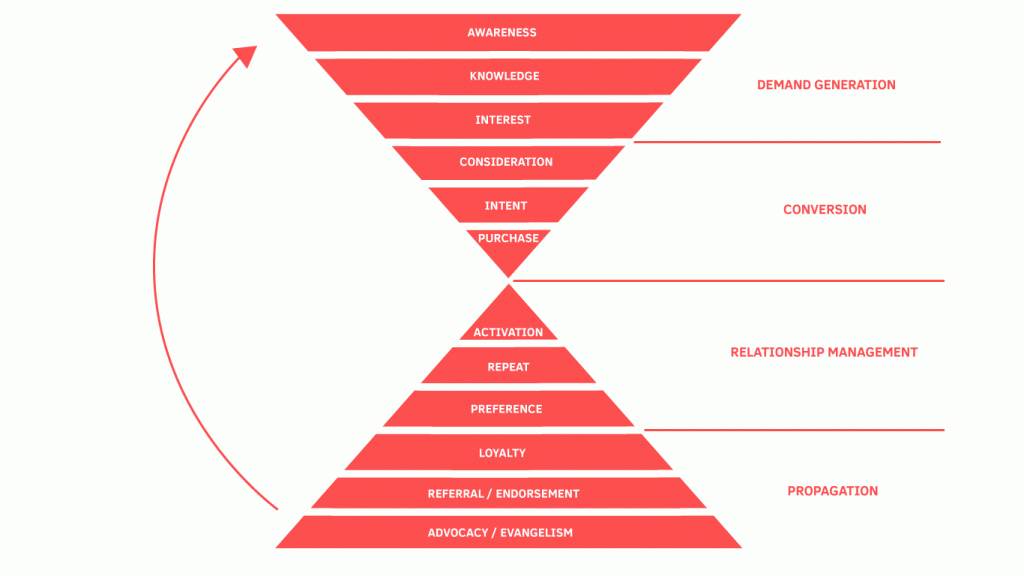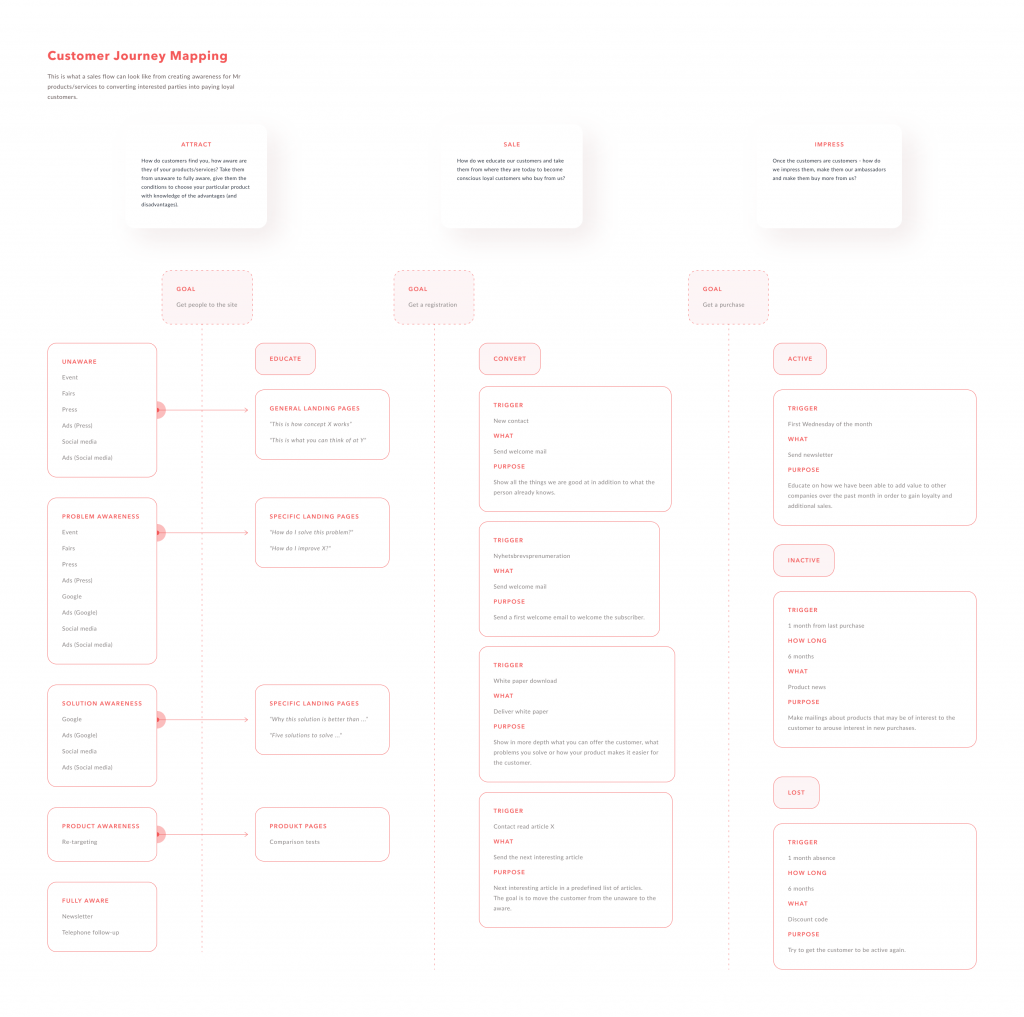
As E-commerce continues to take great leaps forward, you might still be wondering what really makes customers chose to shop with you? This article takes a closer look at how we communicate with our customers, how important data is to increase sales, and which checkout solution actually is the best.
The basis for all marketing development and sales lies in knowing your customers. To have good data to be able to build analyzes from and then use this to help customers make the right decision, ie to make a purchase. Thoughts on this subject were the starting point for a webinar held at the end of 2017 with our CEO Jimmy Rosén, David Linell from Divvit, an analysis tool for E-commerce, and Tim Nilsson from Billmate, a payment service provider.
Customer lifecycle marketing
Customer lifecycle marketing is simply a framework for how to think about your digital marketing. It is a mindset that works just as well whether you run an E-commerce business or a service business. And although this article is primarily aimed at WooCommerce it is, of course, possible to apply these principles to other types of e-commerce sites.
The basis for all future work is to first map out the current situation. Having done that, you can set goals for where you want to go with your digital marketing.
To be able to answer these big questions, it helps to first understand who you are, what you sell, and to whom you sell. We at Angry Creative usually recommend our customers to have a series of workshops. where we can talk about these issues together and then jointly draw the map for your future strategy.
Attract-Sell-Impress
Once the mapping is done, the next step is usually to look at the classic sales hourglass.
Our experience at Angry Creative is this model provides a bit of a simplified picture of reality. We, therefore, use an extended model where the entire customer’s path to purchase is included. Doing so means that we can focus our digital marketing much better on the customer segment that we are actually interested in.
Different types of customers
When creating a landing page with the purpose of converting, the first thing you should do is imagine the customers starting point. In her book, Breakthrough Advertising psychologist Eugene Schwartz sorts customers into different compartments depending on their awareness level when making a purchase.
- Unaware: Do not even know that there is a problem that needs to be solved.
- Problem-aware: Knows that there is a problem, but not really how the problem can be solved.
- Solution Aware: Knows that there is a problem. They know approximately what solutions are available to the problem and what to expect from them.
- Product aware: Knows the problem and that there is a solution. They also have a good idea of what solutions are available. But they do not know why one solution is better than the other.
- Fully aware: Can answer the question of why one solution is better than the other.
What is the customer’s starting point?

If you start thinking this way, you suddenly realize that all landing pages, all content, must be adjusted a little differently at different types of people depending on their prior knowledge. This means that to engage the customer, you need to create a conversation with the customer that takes into account their level of awareness.
A fully conscious customer may just want a big buy button, just to let the purchase be completed quickly. Another customer with less prior knowledge before coming to the site needs the problem you are solving marketed in a way that they can understand, preferably through different landing pages. They need answers to questions such as; What kind of business is this? Why should I care? Is there anyone else who cares? Depending on which customer category the information is aimed at, a customized address is needed. Otherwise, it is unlikely to lead to conversion.
What do we want the customer to do?
All marketing should have a clearly defined end goal, that for the most part, should be reasonably simple. You want to increase your sales, your leads, and your conversions. Therefore, the next step is to go further and create a stable foundation to start from. You need to set clear, measurable milestones on the way to the end goals to be able to see that you are on the right path. It may be that a customer goes from one level of consciousness to another. That the customer has not only visited the site, but has clicked on from the start page, or even saved a shopping cart.
How do we take the customer from A to B?
Once the foundation for marketing has been laid, a few tools are needed to help the customer get from A to B. We need to create campaigns. We must ensure that the customer’s interest is maintained and that it continues to move in the direction to a purchase. Give the customer a reason to sign up, and you can then use their information to follow up with a targeted campaign. Slowly but surely, the customer is brought ever closer to a completed purchase.
It is easy to focus on the new customers, but it is at least as to maintain focus on already existing customers. By maintaining a customer database, you can see which customers have not shopped in a long time, indicating who customers who may be about to be lost. These customers need a reminder that you exist, perhaps by being advised of a product based on previous purchases. If it has been long enough since the last purchase, it may be worth sending a discount coupon to attract the customer back even if it means you are sacrificing a small part of the profit.
Our experience at Angry Creative tells us that thinking about these issues often lead to ideas about automated flows and thoughts about how and where customers are directed. To take advantage of these ideas in the best way and to be able to create a working concept together, we usually set up a creative workshop with our customers.
Increase sales through data
To set realistic goals and get to know your customers, it is important to collect data. This will form the basis when it is time to analyze from which you can then build your strategies. In order to create change, you need to know where to start, so it is important to start collecting data in a consistent way as early as possible. This process can be broken down into four simple steps.

- Collect all data in one place – This can be done by manual collection in a spreadsheet or by automatic collection via a Google Analytics tool. The most important thing is that all data is in the same format so that you can be able to compare it over time.
- Take action with good timing – To be able to make the right decision, access to the right data at the right time is necessary. This usually means measuring as close to an event as possible. If there is too much time between the campaign and the data point, you will lose the chance to adjust the campaign resulting in that profit may be lost.
- Get to know and segment the customers – In addition to the different levels of awareness, it can be valuable to produce an average customer profile when the data is available. The more data points that are looked at, the clearer picture you will get. In addition to classic factors such as age and gender, it is important to look at things like; time spent on the site, time to purchase, and how many visits are required before purchase.
- Follow the entire journey until purchase – How many visits do the customer make to the site before purchase? Did they come back again? How long have they been on the site?
When the data collection has gotten moving, you might ask yourself, “Where should I start?” Since a high conversion rate and good sales are some of our main goals, it can be good to start from the back in the sales process. By starting as close to the checkout and the purchase as possible, it is easier to ensure your first adjustments have a larger impact. After that, you can work your way further and further forward and start processing the customers who have a lower level of awareness.
Higher conversion rates with the right checkout solution
This leads us into the third method of increasing digital sales; what type of checkout solution should I choose to get the best possible conversion?

Today, there are two main types of checkouts, standard payment solutions, and checkouts. Simply put, a standard payment solution is what comes with a ready-made E-commerce system, a checkout is a solution that comes via a payment service provider.
A standard cash register needs a lot of information and therefore has many fields that need to be filled in. This is an advantage in some cases if you want to add an extra field to offer package wrapping, registration for a newsletter, or something similar. It can also be easier in some cases if you want to be able to offer payment solutions such as PayPal.
A checkout is optimized so that the customer can shop quickly and with the need for as little information be filled in as possible. Simplicity and agility make customers more inclined to buy, fewer clicks lead to more purchases. A checkout is delivered as a ready-made plugin from a payment service provider, which is responsible for its maintenance and reliability. It is more dynamic as it can customize the shopping experience by, for example, only showing the payment solutions available to that particular customer.
Which one should I choose?
There is no general answer to this question. It simply depends on who the customers are. By collecting and analyzing data, it is possible to get a good picture of who they are and their needs and wishes. Test and see how it seems to work. It is also possible to do a customer survey and ask customers straight away what they think is important when they shop and how they would prefer to pay. Overall, it is still the case that checkout today is making great strides as a solution due to its flexibility both for customers and for those who run the site. If you want to know more about WooCommerce and different payment solutions, you will find it in An introduction to WooCommerce.
How do I get started with Customer lifecycle marketing? – 3 quick tips

Map – Start by mapping and building the company’s journey. Where are you now and where do you want to go? Do not limit yourself with technicalities. Instead, dream freely to find your goal. Use the model for customer lifecycle marketing and you will find a number of different measures to work on. Then look at your collected data and build the implications that it gives you.
Start simple – A lot can be done with simple tools. Data can be collected manually in a spreadsheet. If you use WooCommerce, you can, for example, use the “follow up emails” plugin which is an easy way to create automation. Gradually, you can then acquire more advanced systems such as a marketing automation system.
Iterate – Data collection and analysis is the most important thing you can do, regardless of which tools you choose to use. Be sure to collect all data in the same format and in the same place. Analyze and try to find the things that stand out in the data. As long as data is collected continuously, one can start analyzing quite early. No more than 20-100 orders are needed evenly distributed over time before it is possible to start distinguishing patterns. Based on the data, you can then create theses for improvement that you can then test. Then you do the same thing over and over and over again. The more you do it, the better you get at it, ultimately benefiting your company more and more the longer you go.
The most important thing of all when it comes to trying to increase your digital sales is to start working with it today. Most actions require time and fine-tuning before you see the results. If you find this difficult, contact a WooCommerce-expert who can help guide you. Also do not forget that since it is an ongoing task, it is important to have a stable site to build from. We at Angry Creative provide services both as a WordPress agency and through WordPress administration.
You may also be interested in these articles
Brexit for WooCommerce sellers
The impact of Brexit is huge. There are very many implications for those in e-commerce businesses…
Read more
Brexit for WooCommerce sellers
Cynefin: a valuable framework to classify, communicate and respond to tasks in digital projects
Cynefin. At Angry Creative we think it’s a vital part of digital projects. It helps us to underst…
Read more
Cynefin: a valuable framework to classify, communicate and respond to tasks in digital projects
Web fonts for WordPress
Fonts control how your text is displayed – how the letters actually look. web-safe fonts. W…
Read more
Web fonts for WordPress
Subscribe to our newsletter for tips, inspiration and insight about WordPress and WooCommerce and the digital world beyond.
Time to take the next step towards a more effective website?
Contact us, and we can talk more about how we can take your business to the next level together.

